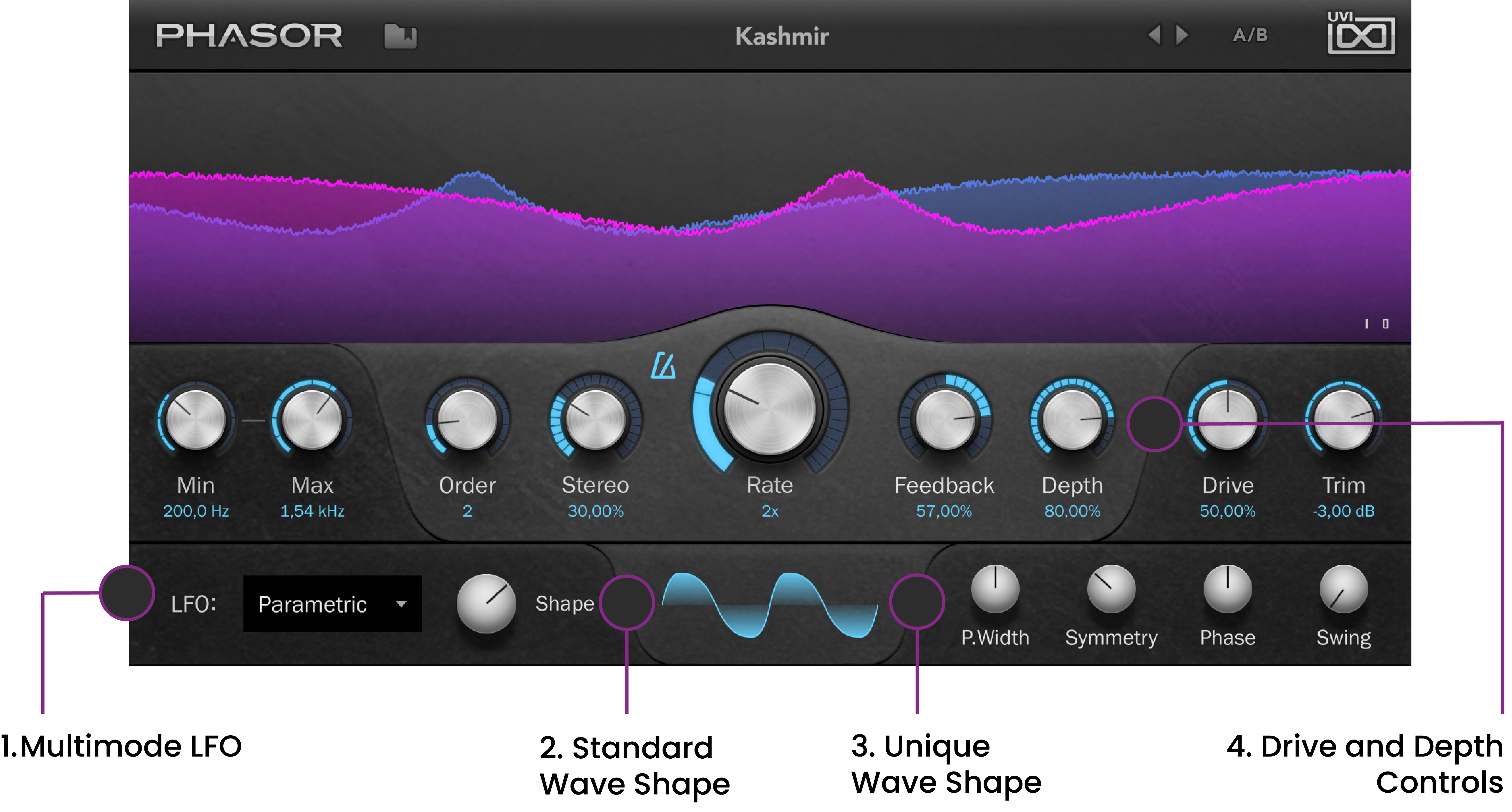

Phasor is an incredibly useful modulation effect that has its roots in the latter half of the 60’s. From Hendrix to Lenny Kravitz, the phase shifter has been a staple in the rig of psychedelic guitarists since its invention. As the phase shifter began to shift into mainstream use, many producers began to utilize the unique effect on other instruments from keyboards to vocals. You can find the phase shifter in rock, funk, hip hop, pop, jazz, and more. What goes into designing a great phase shifter and how did team UVI go about reimagining it? Let’s dive in and take a look!
In order to understand what UVI Phasor is doing to your sound, it’s important to know how a phase shifter works. The phase of an audio signal is a measurement of ‘how far along in its waveform it is’. When you think of the crest or trough of your waveform, you can easily visualize this. Imagine taking the absolute peak of your waveform and making it happen a bit later in time with delay. This is the beginning of the phase shifter effect.

With many phase shifting effects, you can even add in some feedback and adjust the length of the delay induced in the signal. This will allow you to accentuate the ‘swirling sweep’ effect and make it feel faster or slower and more or less pronounced. Some phasers even give you control over filtering of the phased signal as well, allowing for even more control over the audio artifacts!
UVI Phasor was first developed as an insert/send effect for Falcon. Running a variety of synths and samples through Phasor allowed our users to create some really cool tracks, and we quickly received requests to develop a standalone version of the effect that could be used in any DAW and on any sound source.Phasor gives you an incredible amount of control over the phase shifting effects and audio artifacts that are produced. The engine itself is the timeless phaser engine that users of phase shift effects have come to know and love. It’s in the control and extra features, however, that Phasor really sets itself apart and shines.

The visual design of Phasor also allows you to have a real guide to how the controls you are adjusting will affect the sound. All of these controls and visual elements combine to allow the user to shape Phasor to the perfect settings in record time.
It’s never been a better time to give Phasor a shot! It’s now available as a standalone plugin, and as a part of SonicPass. With a library of wonderful presets and the control you need to design your own sounds exactly as you want them, Phasor is the complete package!
UVI Focus
- UVI Focus - Behind the Sound: The approach powering SonicBundle
- UVI Focus - In conversation with Tonnerre
- UVI Focus - Discover 5 reasons why you need Mosaiq
- UVI Focus - A look at our most celebrated products
- UVI Focus - Rediscover iconic sounds with Doctor Mix
- UVI Focus - Throwback 2024, a year of releases
- UVI Focus - The Art of Tape: Tape Suite and the Revival of analog Techniques
- UVI Focus - Exploring the legends behind Quadra Modular
- UVI Focus - When Creativity Meets Innovation
- UVI Focus - Key Suite's 5 Rare & Unconventional Machines
- UVI Focus - In Conversation with Jean-Claude Chapuis
- UVI Focus - In Conversation With Venus Theory
- UVI Focus - HX-20: Reviving the MS-20 inspiration in 5 timeless tracks
- UVI Focus - In Conversation With Jon Carin
- UVI Focus - 2023 Throwback - A year of inspiration
- UVI Focus - 10 Falcon Power-Features You Should Know
- UVI Focus - Soul Bass & Soul Drums: A Dynamic Duo
- UVI Focus - Synth Anthology 4 - Experiencing Sound Design with MPE
- UVI Focus - The story of KAWAI
- UVI Focus - In Conversation With Antoine Martin
- UVI Focus - Advanced Sound Design Techniques with Falcon Expansions
- UVI Focus - Phasor: The Story of a Mythical Effect
- UVI Focus - 5 Key Features of Percussion Factory
- UVI Focus - The story of Vintage Vault 4
- UVI Focus - In Conversation With Lou Wiss
- UVI Focus - 7 Hidden Gems of Toy Suite
- UVI Focus - PX Guitar Syn, A Piece of Hybrid-Instrument History
- UVI Focus - In conversation with Jordan Rudess
- UVI Focus - IRCAM & UVI, a successful pair
- UVI Focus - Behind-the-scenes of Soul Drums
- UVI Focus - Deep Dive into Synth Anthology 4's modular rarities
- UVI Focus - Deep dive in Falcon's 'Texture' Oscillator
- UVI Focus - In conversation with Simon Stockhausen
- UVI Focus - Deep dive in World Suite 2's Oriental Ensemble
- UVI Focus - Exploring Key Suite Bundle Edition
- UVI Focus - Behind-the-scenes of Walker 2
- UVI Focus - In action with Dual Delay X
- UVI Focus - In action with Shade
- UVI Focus - In conversation with Guillaume Roussel
- UVI Focus - Behind-the-scenes of Augmented Orchestra
- UVI Focus - Behind-the-scenes of UVI





